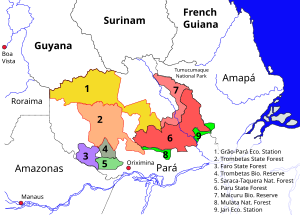Rio Trombetas Biological Reserve
| Rio Trombetas Biological Reserve | |
|---|---|
| Reserva Biológica do Rio Trombetas | |
|
IUCN category Ia (strict nature reserve)
|
|

Protected areas of north west Pará
4. Rio Trombetas Biological Reserve |
|
| Nearest city | Oriximiná, Pará |
| Coordinates | 1°05′02″S 56°37′59″W / 1.084°S 56.633°WCoordinates: 1°05′02″S 56°37′59″W / 1.084°S 56.633°W |
| Area | 407,754 hectares (1,007,580 acres) |
| Designation | Biological reserve |
| Created | 21 September 1979 |
Rio Trombetas Biological Reserve (Portuguese: Reserva Biológica do Rio Trombetas) is a federally-administered biological reserve in the municipality of Oriximiná, Pará, Brazil. It covers a large area of Amazon biome including rainforest, wetlands and water.
The reserve, which covers 407,754 hectares (1,007,580 acres), was created on 21 September 1979. It is managed by the Chico Mendes Institute for Biodiversity Conservation. The objective is to fully preserve the biota and other natural attributes of the reserve without human interference except for recovery of degraded ecosystems and actions to preserve the natural balance, biological diversity and natural ecological processes. A specific objective is to ensure survival of the Arrau turtle (Podocnemis expansa) and other turtles, and to preserve a sample of the Amazon ecosystem. It adjoins the Trombetas State Forest to the north, the Faro State Forest to the east and the Saracá-Taquera National Forest to the south.
The reserve is in the Uatuma-Trombetas moist forests ecoregion. The landscape is rugged, with altitudes that range from 100 to 350 metres (330 to 1,150 ft). It contains exposed rock from an ancient craton and sediments from the Amazon. Temperature ranges from 26 to 32 °C (79 to 90 °F) with average temperature of 27 °C (81 °F). Annual rainfall is about 2,141 millimetres (84.3 in). 86% of the reserve is covered by upland rainforests, 6% by flooding forests and 6.5% by water. The area is drained by the Acapu River and the Arrozal, Candieiro, Mungubal and Cabeceira Grande streams. Numerous lakes in the floodplain are permanently connected to the Trombetas River, forming a large wetland.
The diverse plant species include manilkara huberi, caryocar, dipteryx odorata, chrysophyllum, goupia glabra, copaiba, bertholletia excelsa, anacardium giganteum and palms such as attalea maripa, oenocarpus bacaba and astrocaryum vulgare. Migratory bird species include osprey (pandion haliaetus), collared plover (charadrius collaris) and large-billed tern (phaetusa simplex). The glossy antshrike (sakesphorus luctuosus) is endemic.
...
Wikipedia

